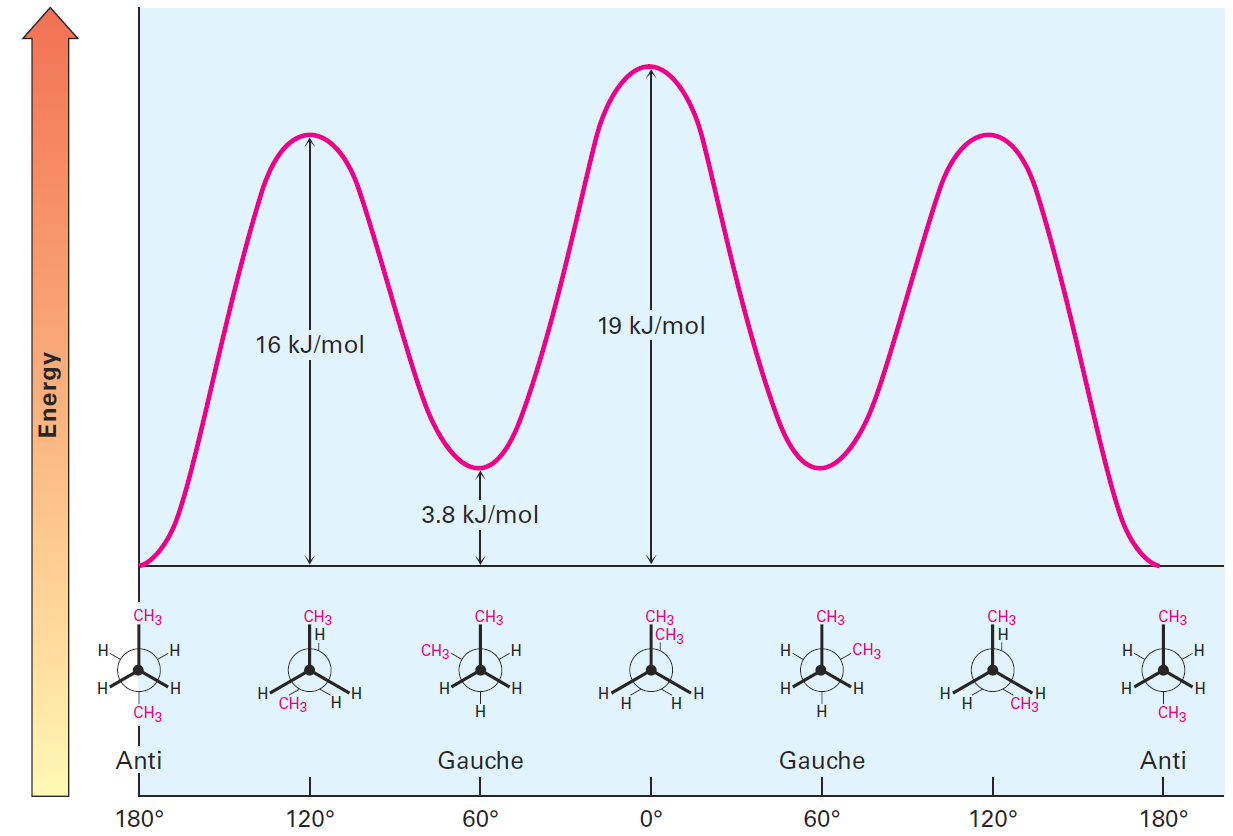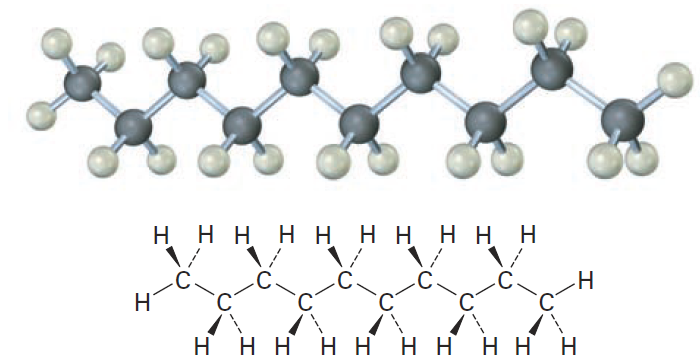
Conformations of Other Alkanes
 المؤلف:
John McMurry
المؤلف:
John McMurry
 المصدر:
Organic Chemistry
المصدر:
Organic Chemistry
 الجزء والصفحة:
9th - p82
الجزء والصفحة:
9th - p82
 12-4-2016
12-4-2016
 4964
4964
Conformations of Other Alkanes
Propane, the next-higher member in the alkane series, also has a torsional barrier that results in hindered rotation around the carbon–carbon bonds. The barrier is slightly higher in propane than in ethane—a total of 14 kJ/mol (3.4 kcal/mol) versus 12 kJ/mol. The eclipsed conformation of propane has three interactions—two ethanetype hydrogen–hydrogen interactions and one additional hydrogen–methyl interaction. Since each eclipsing H←→H interaction is the same as that in ethane and thus has an energy “cost” of 4.0 kJ/mol, we can assign a value of 14 - (2x 4.0)= 6.0 kJ/mol (1.4 kcal/mol) to the eclipsing H←→CH3 interaction (Figure 1).

Figure1: Newman projections of propane showing staggered and eclipsed conformations.
The staggered conformer is lower in energy by 14 kJ/mol. The conformational situation becomes more complex for larger alkanes because not all staggered conformations have the same energy and not all eclipsed conformations have the same energy. In butane, for instance, the lowest-energy arrangement, called the anti conformation, is the one in which the two methyl groups are as far apart as possible—180° away from each other. As rotation around the C2- C3 bond occurs, an eclipsed conformation is reached when there are two CH3←→H interactions and one H←→H interaction. Using the energy values derived previously from ethane and propane, this eclipsed conformation is more strained than the anti conformation by 2x6.0 kJ/mol + 4.0 kJ/mol (two CH3 ←→ H interactions plus one H←→H interaction), for a total of 16 kJ/mol (3.8 kcal/mol).

As bond rotation continues, an energy minimum is reached at the staggered conformation where the methyl groups are 60° apart. Called the gauche conformation, it lies 3.8 kJ/mol (0.9 kcal/mol) higher in energy than the anti conformation even though it has no eclipsing interactions. This energy difference occurs because the hydrogen atoms of the methyl groups are near one another in the gauche conformation, resulting in what is called steric strain. Steric strain is the repulsive interaction that occurs when atoms are forced closer together than their atomic radii allow. It’s the result of trying to force two atoms to occupy the same space.

As the dihedral angle between the methyl groups approaches 0‹, an energy maximum is reached at a second eclipsed conformation. Because the methyl groups are forced even closer together than in the gauche conformation, both torsional strain and steric strain are present. A total strain energy of 19 kJ/mol (4.5 kcal/mol) has been estimated for this conformation, making it possible to calculate a value of 11 kJ/mol (2.6 kcal/mol) for the CH3←→CH3 eclipsing interaction: total strain of 19 kJ/mol minus the strain of two H←→H eclipsing interactions (2x 4.0 kcal/mol) equals 11 kJ/mol.

After 0° , the rotation becomes a mirror image of what wefve already seen: another gauche conformation is reached, another eclipsed conformation, and finally a return to the anti conformation. A plot of potential energy versus rotation about the C2-C3 bond is shown in Figure 2.

Energy
Figure 2: A plot of potential energy versus rotation for the C2- C3 bond in butane. The energy maximum occurs when the two methyl groups eclipse each other, and the energy minimum occurs when the two methyl groups are 180‹ apart (anti).
The notion of assigning definite energy values to specific interactions within a molecule is very useful, and we’ll return to it in the next chapter. A summary of what we’ve seen thus far is given in Table 1-1. The same principles just developed for butane apply to pentane, hexane, and all higher alkanes. The most favorable conformation for any alkane has the carbon–carbon bonds in staggered arrangements, with large substituents arranged anti to one another
Table 1-1 1Energy Costs for Interactions in Alkane Conformers
A generalized alkane structure is shown in Figure 3.

Figure 3: The most stable alkane conformation is the one in which all substituents are staggered and the carbon–carbon bonds are arranged anti, as shown in this model of decane.
One final point: saying that one particular conformer is “more stable” than another doesn’t mean the molecule adopts and maintains only the more stable conformation. At room temperature, rotations around s bonds occur so rapidly that all conformers are in equilibrium. At any given instant, however, a larger percentage of molecules will be found in a more stable conformation than in a less stable one.
 الاكثر قراءة في الهايدروكاربونات
الاكثر قراءة في الهايدروكاربونات
 اخر الاخبار
اخر الاخبار
اخبار العتبة العباسية المقدسة


